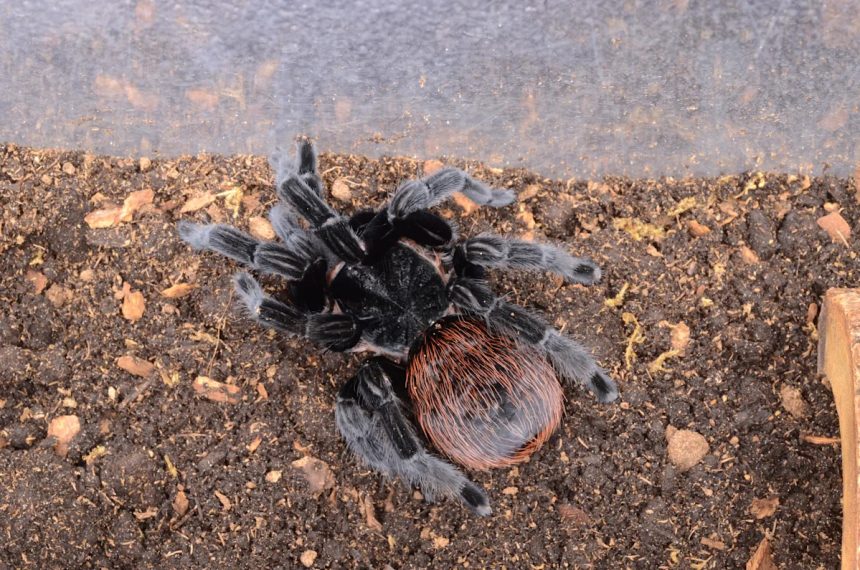Happy tarantula mating season to those who celebrate, which might be a very, very small group.
There are 29 described individual species of tarantulas in the United States, including a nonnative species in Florida.
According to USA TODAY, tens of thousands of tarantulas across the country will be crawling out of their burrows in search of females, making for a fascinating, if a little creepy, display of the wonders of nature.
Are there any tarantulas in Florida?
According to the University of Florida’s Institute of Food and Agricultural Sciences, Mexican red rump tarantulas can be found in Florida.
IFAS notes they range from 2 to 3 inches in size, with males slightly smaller. They are entirely black except for the long red to reddish-brown hairs on the dorsum of the abdomens; females also have these hairs on their legs.
These nonnative species can be found across Central America, including Belize, El Salvador, Guatemala, Honduras and, of course, Mexico. It is unknown exactly how they made it into Florida, with theories ranging from individuals accidentally catching a ride to the state to negative consequences from the commercial pet trade in the 1970s.
Where is the Mexican red rump tarantula found in Florida?
UF/IFAS shares photo of a Mexican red rump tarantula, specifically a newly molted individual. These tarantulas are native to Central American and are an invasive species in Florida. Courtesy, UF/IFAS
These tarantulas can be found throughout South Florida, particularly in citrus groves and overgrown areas. They have not spread into the state’s central and northern regions.
“The area where they are established seems to provide the tarantulas with an abundance of food, water, and proper soil to burrow in, so there does not appear to be a need for them to widely disperse,” IFAS writes. “However, the potential for the species to become widespread in Florida, given enough time, cannot be discounted.”
Are Florida’s tarantulas dangerous?
No, they are not. While they are venomous, their venom is not typically dangerous to humans. Their bite can still be painful and can cause an allergic reaction.
As for their behavior, they are considered decently docile but can bite or flick their hair if they feel threatened. Fear Not Tarantulas writes that they are considered one of the most “handleable tarantulas,” but they still do not recommend handling them.
It is mainly recommended to leave them alone.
“It’s a wild animal – it doesn’t want to be picked up and loved and hugged,” Dan McCamish, a senior environmental scientist with California State Parks, said to USA TODAY about tarantulas as a whole. “In general, the species is very docile, but if you were to handle one, they could bite you.”
When are you likely to see tarantulas in the wild?
IFAS says Mexican red rump males and females with young seem to be most prevalent in the autumn, which is their mating season.
However, specimens of all sizes can be found year-round. They are nocturnal predators who feed on ground-dwelling arthropods and possibly on small vertebrates.
How do you convince a tarantula to go away?
It’s not uncommon for a tarantula to wander into campsites or tents during their mating season. McCamish gave USA TODAY suggestions for those who come across a tarantula in their space: to gently and safely encourage it to be on its way, the best method is to find a stick and give it a “light tickle” on its abdomen to get it to move away.
“Just give it a light boop on the base of its abdomen and generally they’ll move in that direction,” he said.
If the tarantula has come into contact with your clothing, bedding or a pillow, it’s recommended to wipe it down or even take duct tape and dab it on the surface to remove any of the irritating hairs that might have stuck.
Which states have tarantulas? See species
According to USA TODAY, tarantulas prefer dry climates and primarily live in Western and Southwestern states with arid and semi-arid habitats. They are most prevalent in Arizona, California, Texas, New Mexico, Nevada, Utah, Colorado, Oregon and Washington.
However, they are also found in other states, such as Florida, Missouri and Oklahoma.
Common species include the desert blonde tarantula and the Texas brown (though Texas has 14 tarantula species). In Arizona, there’s even a variety with a fiery-red abdomen.
What’s the deadliest spider in Florida? It’s not a tarantula
Florida is home is thousands of creepy, crawly creatures. According to the Florida Department of Agriculture, only two main types of venomous spiders live in the state: widow spiders and recluse spiders.
“Both types of spiders tend to be found in similar places, which is in or under objects where their presence is not necessarily obvious,” the department shares. “If you are lifting boards or firewood, reaching into storage boxes, or doing other activities that involve putting your hands into places you can’t see, you should wear gloves to prevent being bitten by a hidden spider.”
Elizabeth Weise, USA TODAY, contributed to this report.
This article originally appeared on Palm Beach Post: Tarantula mating season: What Floridians should know ahead of time









